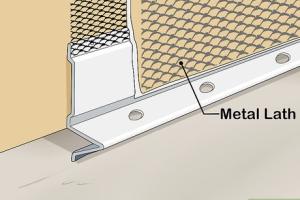Mastering the Art of Stucco: Your Comprehensive Guide to Stuccoing a House

-
Quick Links:
- Introduction
- What is Stucco?
- Benefits of Stucco
- Preparation for Stucco Application
- Tools and Materials Needed
- Step-by-Step Application Process
- Cure Time and Maintenance
- Troubleshooting Common Stucco Problems
- Case Studies and Real-World Examples
- Expert Insights on Stucco
- FAQs
Introduction
Stucco is a time-honored exterior finish that combines aesthetics with durability. Its versatility and ease of application make it a popular choice for homeowners looking to enhance the curb appeal of their residences. This guide will delve into the intricacies of stucco application, providing you with the knowledge and confidence to tackle this home improvement project yourself.
What is Stucco?
Stucco is a mixture of cement, sand, and lime that is applied as a thin layer on exterior walls. It can be textured, colored, or finished in various ways to achieve different looks. Understanding the composition of stucco can help you make informed choices about your project.
Benefits of Stucco
- Durability: Stucco is resistant to fire and can withstand harsh weather conditions.
- Low Maintenance: Once applied, stucco requires minimal upkeep.
- Energy Efficiency: Properly applied stucco can provide insulation benefits.
- Aesthetic Appeal: It offers a classic look that can be customized with various textures and colors.
Preparation for Stucco Application
Before applying stucco, proper preparation is crucial. This includes assessing the surface, repairing any damage, and ensuring it is clean. Follow these steps for effective preparation:
- Inspect the surface for cracks and holes.
- Repair any damage using a suitable filler.
- Clean the surface to remove dirt and debris.
- Moisture-check the surface to ensure it’s dry.
Tools and Materials Needed
Having the right tools and materials is essential for a successful stucco application. Here’s a comprehensive list:
- Cement mixer
- Float and trowel
- Hawk
- Spray bottle for water
- Stucco mix (ready-mixed or dry)
- Mesh for reinforcement
- Protective gear (gloves, goggles)
Step-by-Step Application Process
The stucco application process can be broken down into several key stages:
1. Mixing the Stucco
Follow the manufacturer’s instructions to properly mix your stucco. The consistency should be similar to peanut butter.
2. Applying the Scratch Coat
Apply the scratch coat to a thickness of about 1/4 inch. Use a trowel to spread the mixture evenly and create grooves with a scratching tool for better adhesion.
3. Applying the Brown Coat
Once the scratch coat has cured, apply the brown coat. This layer helps in achieving a smoother finish.
4. Final Coat
The final coat is applied with a trowel and can be textured based on your preferences. Allow adequate drying time between coats.
Cure Time and Maintenance
Curing time for stucco generally requires about 48-72 hours. However, full curing can take several weeks. Regular maintenance involves cleaning and inspecting for cracks.
Troubleshooting Common Stucco Problems
- Cracking: Causes can include improper mixing or application. Repair with a suitable filler.
- Moisture Issues: Ensure proper drainage and avoid applying stucco in wet conditions.
Case Studies and Real-World Examples
Here, we explore a few successful stucco projects showcasing various techniques and finishes. For instance, a historic home renovation utilized a custom color blend to match the original stucco, highlighting the importance of authenticity in restoration projects.
Expert Insights on Stucco
We interviewed industry professionals who emphasized the importance of using high-quality materials and proper techniques. They also recommend consulting local building codes before beginning your project.
FAQs
- What is the best weather for applying stucco? Ideally, stucco should be applied in dry weather with temperatures between 50°F and 90°F.
- Can I stucco over siding? Yes, but ensure the existing siding is in good condition and properly prepared.
- How long does stucco last? With proper maintenance, stucco can last 50 years or more.
- Is stucco energy efficient? Yes, when applied correctly, stucco can improve insulation.
- Can I paint stucco? Yes, but it’s best to use a breathable exterior paint.
- How can I prevent cracking? Ensure proper mixing, application, and curing conditions.
- What tools do I need for stucco application? Essential tools include trowels, floats, hawks, and a cement mixer.
- What’s the average cost to stucco a house? Costs can vary widely, typically ranging from $6 to $9 per square foot.
- How do I repair damaged stucco? Clean the area, fill cracks, and patch with matching stucco mix.
- Do I need a permit to apply stucco? It depends on local regulations; check with your city’s building department.
Random Reads